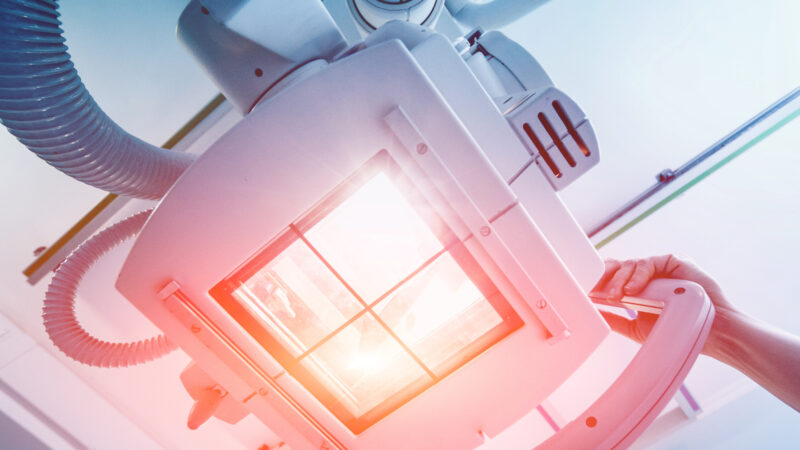Appointments
The James Cook University Hospital:
Friarage Hospital:
What is an x-ray?
X-ray examinations create an image using a beam of electromagnetic radiation to see inside your body. The radiation does not stay inside you or make you radioactive.
As the x-rays pass through the body they are absorbed at different rates, depending on how dense the tissues are, depends on how much x-ray radiation they absorb. An image receptor positioned on the other side of the body picks up the x-rays after they have passed through your body and turns them into an image.
Quick, professional, clean, everything was done to make the patient feel relaxed, safe and valued
X-ray patient, Friarage Hospital
X-ray examinations have many uses including:
Showing broken bones
-
Assessing your tooth position
Checking on progress of an illness or injury
Helping carry out an internal procedure as part of your treatment.
What happens during the x-ray?
A radiographer will take you into the x-ray room and may ask you to sit in a special x-ray chair, lie down on an x-ray table or stand up, depending on the x-ray examination. Alternatively, you may be brought to x-ray on a trolley or wheelchair. We will do our best to adapt the techniques used to suit your needs, whilst still being able to produce a clear x-ray image.
A small positioning light will be used to determine the area you are having x-rayed. We will ask you to stay still whilst the x-ray is being taken and may ask you to hold your breath for a few seconds. You may also hear a slight whirring noise and beep from the machine.
What does the machine look like?
Depending on the reason for your x-ray it will sometimes mean that you will need to go to a different room and the radiographers will use a different x-ray unit. Below is an example of an x-ray unit.

Preparing for an x-ray?
Normally, there is no special preparation necessary for an x-ray examination. However, you may be asked to change for your x-ray if your clothing is thick or has decoration.
Metal, glitter, thick elastic or ties, long hair and nappies tend to show up on x-rays, so it is important that they are removed. You may prefer to arrive for your x-ray in clothes which are made from thin materials and do not contain artefacts. It will not be a problem if you need to get changed, we provide gowns and scrubs to change into if required.
You should remove any valuables and jewellery – It would be best to leave these at home wherever possible
How long does an x-ray take?
An x-ray should not take long (the examination can be as little as five minutes), some x-rays will take longer than others depending on the type of x-ray you are having or how many images are required.
They explained everything about the X-ray then told me how long it would take until my results came back. They answered all my questions and were very knowledgeable and friendly.
X-ray patient, Guisborough Hospital
Radiation dose and risk
X-rays use ionising radiation which can cause cell damage that may, after many years or decades, turn cancerous. The risk of this happening is very small compared to the normal
Lifetime risk of developing cancer which is one in two. We are also all exposed to background radiation every day.
The risk of long-term effects is considered when the healthcare team decide whether someone needs an x-ray examination, and radiation doses are kept as low as possible. If your healthcare team have asked for an x-ray, then it will be considered that the benefit of having the x-ray, is greater than the risk of the small dose of radiation.
What if I am, or possibly am pregnant?
Exposure of an unborn baby to ionising radiation may cause a slight increase in their cancer risk. For this reason, x-ray examination of the abdomen or pelvic area are usually avoided when pregnancy is possible or confirmed, unless the risk of not performing the x-ray is greater.
You must tell your healthcare team if there is any possibility of being pregnant.
You may be asked if you are between the ages of 11 to 55 years old if there is any chance of pregnancy.
X-rays of parts of the body located far away from the abdomen, such as limbs (arms and legs) and dental x-rays, do not give any increased risk to an unborn baby.
If you have to bring children requiring supervision with you for your appointment, please ensure that they have someone to supervise them whilst you are having your x-ray.
Staff within the department are unable to assist with the supervision of young children. In these instances, you may be asked to re book your appointment to a time more suitable for you to have childcare arrangements in place
How do I get my results?
As soon as the x-ray is finished, you will either go back to the referring department (if required for example outpatients), or you may be able to go straight home.
Your x-ray will be looked at by a reporting radiographer or a radiologist (a doctor specialising in imaging), and the results sent back to your referring healthcare team. The timeframe for reports to be sent back will vary depending on the urgency of your x-ray.
The results will be sent to the doctor or healthcare team who referred you for the x-ray.
